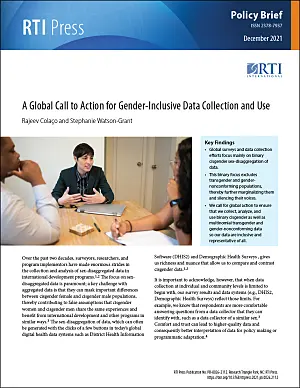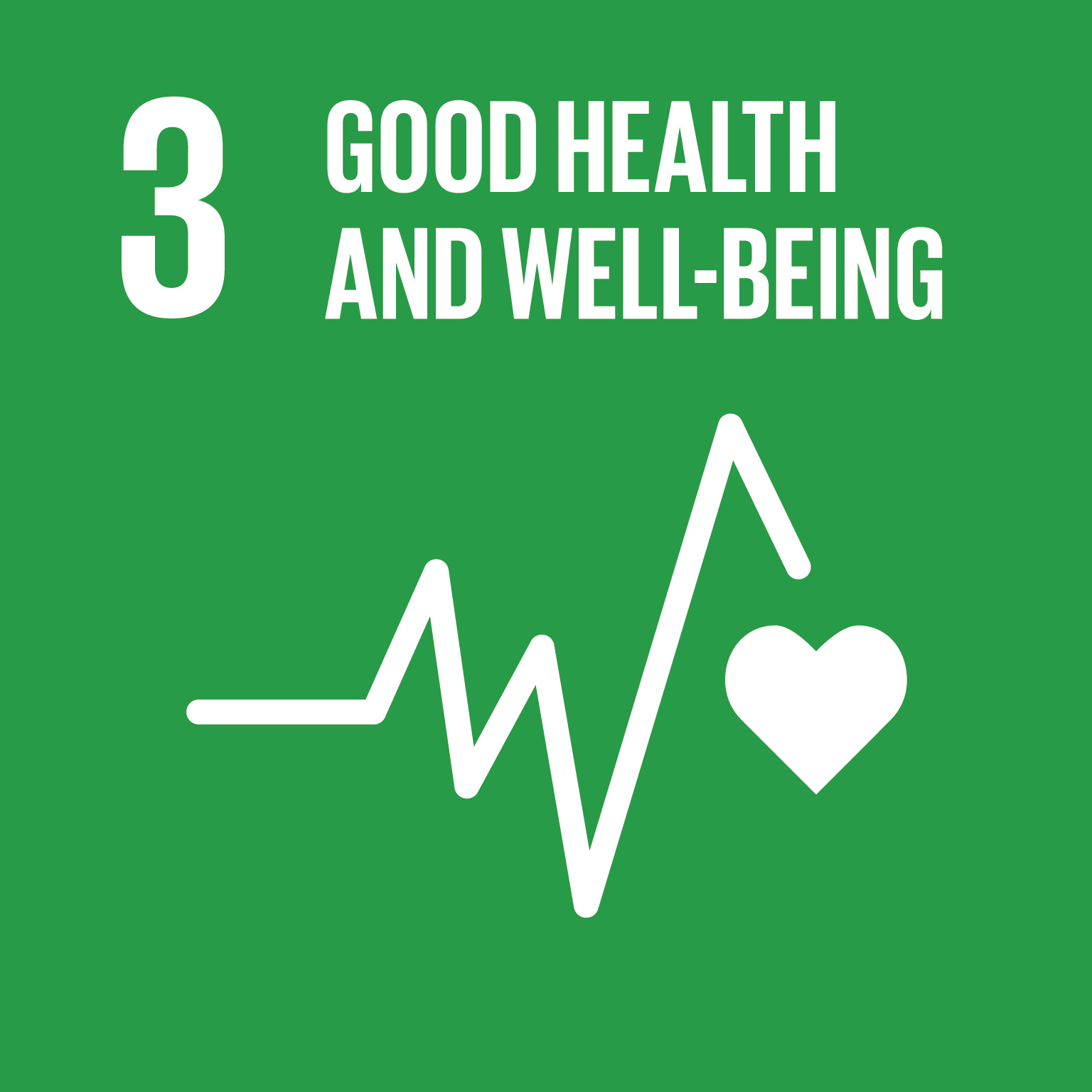Over the past two decades, surveyors, researchers, and program implementors have made enormous strides in the collection and analysis of sex-disaggregated data in international development programs (Sherwood et al., 2017; Victora et al., 2019). The focus on sex-disaggregated data is paramount; a key challenge with aggregated data is that they can mask important differences between cisgender female and cisgender male populations, thereby contributing to false assumptions that cisgender women and cisgender men share the same experiences and benefit from international development and other programs in similar ways (Morgan et al., 2016). The sex-disaggregation of data, which can often be generated with the clicks of a few buttons in today’s global digital health data systems such as District Health Information Software (DHIS2) and Demographic Health Surveys , gives us richness and nuance that allow us to compare and contrast cisgender data (Morgan et al., 2016; Victora et al., 2019).
Key Findings
Global surveys and data collection efforts focus mainly on binary cisgender sex-disaggregation of data.
This binary focus excludes transgender and gender-nonconforming populations, thereby further marginalizing them and silencing their voices.
We call for global action to ensure that we collect, analyze, and use binary cisgender as well as multinomial transgender and gender-nonconforming data so our data are inclusive and representative of all.
It is important to acknowledge, however, that when data collection at individual and community levels is limited to begin with, our survey results and data systems (e.g., DHIS2, Demographic Health Surveys) reflect those limits. For example, we know that respondents are more comfortable answering questions from a data collector that they can identify with, such as a data collector of a similar sex (Morgan et al., 2016). Comfort and trust can lead to higher-quality data and consequently better interpretation of data for policy making or programmatic adaptation (Hunt, 2004).
Many surveys and electronic data systems, including ones such as DHIS2 that are used across countries, allow us the flexibility to collect and enter not only sex-disaggregated cisgender data but also gender-disaggregated data from transgender and gender nonconforming people (Begum et al., 2020) (see Table 1 for a comparison between sex and gender disaggregation). However, the reality is that we still do not accurately and comprehensively collect gender-disaggregated data in most of our standardized surveys and data collection systems. This holds true in resource-sufficient as well as resource-constrained settings. In the United States, for example, one study has identified that out of 100 federal surveys, only 11 collect some sexual orientation and gender identity data (Velte, 2020). Although there is still a focus, understandably and laudably, on women’s and girls’ equity issues (Romanelli & Lindsey, 2020), the global policy landscape has not evolved to include gender data considerations beyond the binary.
Table 1.
76587Key differences between sex and gender-disaggregated data
Note: We acknowledge that although this is the currently used language and terminology that surveys and data collection methods use to capture gender identities, the terminology is constantly evolving—as it should—to better capture the nuances and diversity of all gender identities.
a Refers to people whose gender identity is congruent with the gender they were assigned at birth.
b Refers to an umbrella term used to describe people whose gender identity is inconsistent with the gender they were assigned at birth.
c Refers to people with a gender identity that falls outside of the gender binary of male and female. They may identify as both male and female or as another gender, or their gender identity may change over time.
Sources: University of San Francisco LGBT Resource Center (https://lgbt.ucsf.edu/glossary-terms), RTI Guide to Research with LGBTQ Populations (internal document, 2021), University of California, Los Angeles (UCLA) Williams Institute SOGI Adult Measures Recommendations (http://williamsinstitute.law.ucla.edu/wp-content/uploads/SOGI-Measures-FAQ-Mar-2020.pdf).
Complexities of Collecting High-Quality, Confidential Gender-Disaggregated Data and COVID-19’s Gap in Gender Data
Gender-disaggregated data are lacking for several reasons, including political resistance; laws that criminalize and persecute non-cisgender people; stigma and discrimination around collecting gender-disaggregated data; and a lack of adequate awareness and training for both data collectors and respondents around gender definitions, gender-sensitive language, and data protection and confidentiality (Day et al., 2016; Spade, 2015).
The ongoing COVID-19 pandemic has once again brought to the forefront the importance of de-stigmatizing transgender and gender-nonconforming people, given that marginalized populations are often excluded from adequate testing, care and treatment, and vaccinations (Kramer, 2021; Romanelli & Lindsey, 2020). Several studies and guidelines have emphasized the importance of sex-disaggregated COVID-19 data and highlighted sex-specific (cisgender female and cisgender male) differences in immunity, pharmacology, and vaccine outcomes (Pan American Health Organization, 2020; Vijayasingham et al., 2021; Womersley et al., 2020). However, there is a global dearth of studies that examine these differences for transgender and gender-conforming people.
Steps Toward Collecting and Using Gender-Disaggregated Data: Beacons of Hope
Despite pressing challenges, there are encouraging examples of progress toward collecting, analyzing, and using gender-disaggregated data (see Table 2). For instance, in the United States, the Behavioral Risk Factor Surveillance System (BRFSS) collects data from nearly half a million adults each year, gathering data on health-related risk behaviors, chronic health conditions, and use of preventive services. It is often referred to as the largest continuously conducted health survey system in the world (Centers for Disease Control and Prevention, n.d.). The system has historically collected only cisgender female and cisgender male-specific data, but from 2014 onward it has been collecting gender-disaggregated data in most US states (Centers for Medicare & Medicaid Services, n.d.). Studies from BRFSS and other data sources have shown that gender-nonconforming respondents have significantly higher odds of reporting poor self-rated health than any other gender identity group (Lagos, 2018; Romanelli & Lindsey, 2020). This is a relevant example of how, when our surveys and data systems are set up to collect and present gender-disaggregated data, those data can then be analyzed and shown to relevant stakeholders and policy makers.
Table 2.
76588Examples of surveys and data systems collecting gender-disaggregated data
| Data System or Survey | Key gender-disaggregation characteristics |
|---|---|
| Behavioral Risk Factor Surveillance System (BRFSS) (https://www.cdc.gov/brfss/index.html) —US geographic focus | |
| People Living with HIV (PLHIV) Stigma Index (https://www.stigmaindex.org/about-the-stigma-index/what-is-the-people-living-with-hiv-stigma-index/) —Global focus | |
| Census systems in Bangladesh, India, Nepal, and Pakistan (in phases from 2007 onward; https://www.ispionline.it/en/pubblicazione/third-gender-rights-south-asia-whats-new-25354) —South Asia geographic focus |
Globally, strides in programming sex and gender-disaggregated data in data systems have been made in the field of HIV prevention and treatment (Sherwood et al., 2017). One example is the People Living with HIV (PLHIV) Stigma Index, which is a standardized tool to gather evidence on how stigma and discrimination affects the lives of people living with HIV (Global Network of People Living With HIV, n.d.-b). The tool was first launched in 2008, and since then, it has been implemented in more than 100 countries, with more than 100,000 PLHIV participating in the process. A unique feature of this index is that it was developed to be used by and for people living with HIV. The index collects gender-disaggregated data and also intentionally trains and recruits interviewers who are living with HIV and interviewers from other key populations, such as men who have sex with men, transgender people, and gender nonconforming people (Global Network of People Living With HIV, n.d.-a). This helps increase familiarity and trust between respondents and data collectors, and thus is a best practice that surveyors and researchers can replicate in other data collection efforts. Studies analyzing PLHIV Stigma Index data show that transgender people experience high levels of stigma (Friedland et al., 2020). If these data were not collected, it would be impossible to fill knowledge gaps and make informed decisions to benefit people living with HIV.
Another example of positive change comes from South Asian countries such as Bangladesh, India, Nepal and Pakistan. Thanks to concerted advocacy efforts, the past two decades have seen governments of these countries for the first time include the option of a third gender in their official national census and voter rolls (Ahmed, 2020). Advocacy efforts continue in this area, especially because there is valid criticism that the census options are still limited in that they classify all people who do not identify as female or male into an “other” category, thereby failing to acknowledge and appropriately capture the nuances and fluidity of gender disaggregation (as highlighted in Table 1) of transgender and gender-nonconforming people (Sharma & Banerji, 2020).
Recommendations to Capture High-Quality Gender-Disaggregated Data
Gender-Inclusive Questions in Data Collection
There have been several recommendations for how surveyors, researchers, and program implementors can improve data collection efforts to capture gender-disaggregated data as accurately as possible. One recommendation that has been getting increasing acceptance among surveyors is to include two sets of questions to capture the nuances of sex and gender-disaggregated data more comprehensively. One question asks respondents their assigned sex at birth (usually a binary option of female or male), and the other question asks respondents what they consider their current gender to be, with a range of response options that reflect the diversity and fluidity of gender (Lombardi & Banik, 2016). Tables 3 and 4 offer some concrete recommendations for gender disaggregation questions. Table 3 includes sex and gender within a single question (which could be confusing for data collectors and respondents), and Table 4 separates sex and gender in distinct questions.
Table 3.
76589Two-step gender status measurement questions
Note: We acknowledge that although this is the currently used language and terminology that surveys and data collection methods use to capture gender identities, the terminology is constantly evolving—as it should—to better capture the nuances and diversity of all gender identities. One limitation of these particular questions is that there is no explicit “Intersex” response option, which could result in intersex respondents not being able to adequately identify their gender.
Source: Lombardi & Banik (https://doi.org/10.1007/s13178-016-0220-6); Bauer et al. (https://doi.org/10.1371/journal.pone.0178043).
Table 4.
76590Question sequence with separate questions for gender and sex measurement
Note: We acknowledge that although this is the currently used language and terminology that surveys and data collection methods use to capture gender identities, the terminology is constantly evolving—as it should—to better capture the nuances and diversity of all gender identities. One limitation of these particular questions is that there is no explicit “Intersex” response option, which could result in intersex respondents not being able to adequately identify their gender.
Source: University of California, Los Angeles (UCLA) Williams Institute Sexual Orientation and Gender Identity (SOGI) Adult Measures Recommendations (http://williamsinstitute.law.ucla.edu/wp-content/uploads/SOGI-Measures-FAQ-Mar-2020.pdf).
Gender-Sensitive Training for Data Collectors and Respondents to Ensure Gender Data Accuracy, Confidentiality, and Anonymity
Merely including gender-disaggregation options in data collection efforts is unlikely to automatically result in the capture of better gender-disaggregated data. Data collectors and respondents need to be primed to the importance of adequate training and gender sensitization when gender questions are asked (Romanelli & Lindsey, 2020; University of San Francisco LGBT Resource Center, n.d.). Particularly for marginalized respondents, political and societal stigma and discrimination can be barriers to disclosure of gender status. Data collection efforts are increasingly emphasizing culturally appropriate gender sensitization and assurance of anonymity and data protection. For example, the PLHIV Index emphasizes that PLHIV respondents (including transgender respondents and respondents from other populations) have buy-in and ownership over the data collection and analysis process, as well as in advocacy efforts to reduce and eliminate stigma. In addition, the PLHIV Index recruits diverse teams of data collectors that include transgender and gender non-conforming people (Pan American Health Organization, 2020). This is a best practice that other data collection efforts can emulate, as studies have shown that respondents are more comfortable answering questions from data collectors that they can identify with on a personal level. We need to continue to balance the desire for high-quality gender data with the importance of ensuring data privacy, confidentiality, and anonymity. We also need to ensure that adequate human, financial, and time resources are allocated to gender-sensitive data collection efforts, including sensitization, training, and quality testing of gender-disaggregation questions and instruments. These efforts can generate gender evidence that in turn can educate policy makers about the complexity of gender and support marginalized gender communities in ways that can help reduce stigma.
Limitations of This Call to Action
The limitations to this call to action largely reflect the challenges associated with the lack of adequate and high-quality gender-disaggregated data across the world. For example, a key limitation behind the availability of gender-disaggregated data in some countries and regions is that it is not legal in those settings to acknowledge the presence of noncisgender people. Even where the law might not prohibit collection of gender-disaggregated data, including in resource-sufficient settings such as the United States, there is insufficient political will to collect gender-disaggregated data or lack of sensitization and training to ensure that gender-disaggregated data are collected in a thoughtful, respectful, and confidential manner. Lastly, because gender-disaggregated data are still sparsely available, there is not a rich repository of evidence in the global literature to show how gender-disaggregated data collection and analysis can lead to wide-reaching policy change. Having said that, experience from South Asian countries—as described elsewhere in this brief—shows that continued focus and advocacy efforts by and for marginalized gender populations has resulted in changes in discriminatory practices and the inclusion of noncisgender populations in national censuses.
A Call for Sustaining Gender Advocacy Efforts and Policy Change
Advocacy, sensitization, and training have helped us make huge strides and can continue to play an important role in ensuring that our surveys and data collection processes are adequately designed and set up to collect both sex and gender-disaggregated data. We still have a long way to go, however. Surveyors, researchers, program implementors, and gender rights advocates can work together to design and implement surveys and data collection instruments that explicitly capture gender-disaggregated data. In addition, they can help ensure that both data collectors and respondents are adequately sensitized, trained, and resourced in gender definitions and respectful, nonjudgmental, and confidential data collection. Through these collective efforts, our data can be representative of all citizens and populations: cisgender, transgender, and gender nonconforming. Gender-disaggregated data in particular can make often invisible, hidden, and marginalized transgender and gender-nonconforming people more visible to national-level policy makers and governments. The evolution from largely binary sex-disaggregation to more-inclusive, multinomial gender-disaggregation that is representative of gender fluidity is an important step toward strengthening data quality and making those data more inclusive and equitable.




